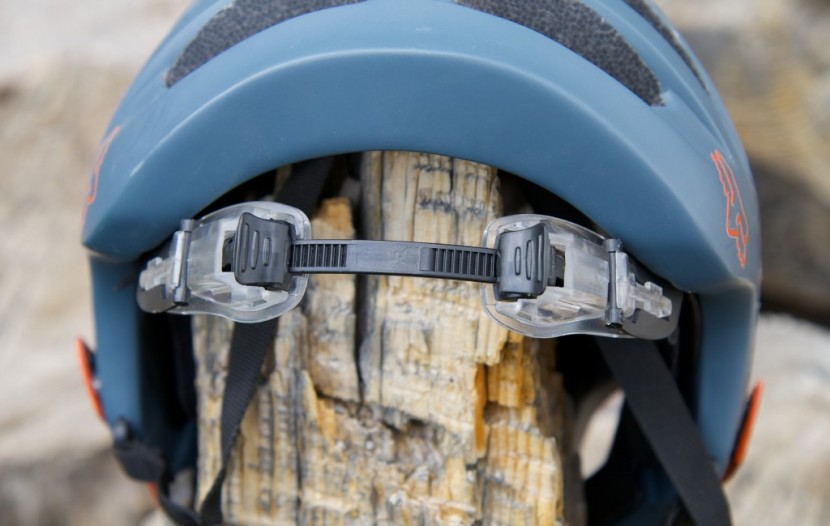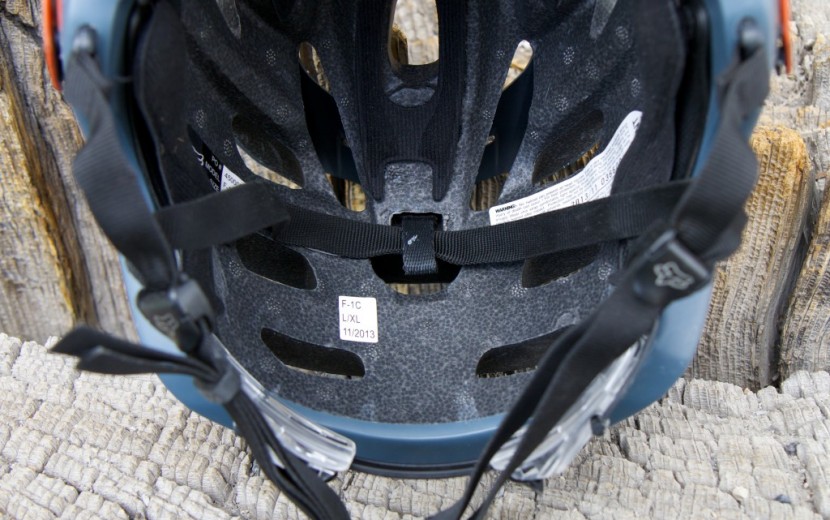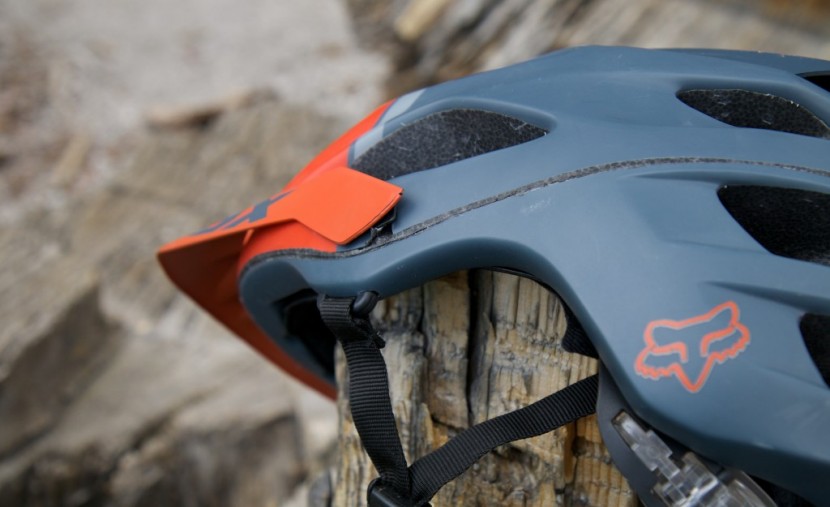Fox is better known for its full-face offerings, apparel, and protective gear. The Flux is one of the two half-shell mountain bike helmets they currently produce. The other is the Striker, which we have not yet tested. Unfortunately, we think there are much better options in the extended coverage half-shell mountain bike helmet market.
Our absolute favorite helmet is the Troy Lee A1 which earned a high score in all of our tests and took top scores in comfort and durability. If you wear goggles while you ride, we highly recommend the Bell Super which has an awesome visor that can accommodate goggles being worn on the front of the helmet while you climb. If you are a more cross-country oriented rider we recommend the uber light Giro Xar.Fox Flux Review
Our Verdict
Our Analysis and Test Results
The Fox Flux is a half-shell mountain bike helmet composed of polystyrene foam covered in a polycarbonate shell. Its shell wraps completely around the foam, which increases durability. It has a very basic retention system which lacks an adjustment wheel. The Flux has an average sized visor that is is attached by snaps which do not allow it to be locked in an one place. The Flux also has a spoiler attached to the rear of the helmet which is made from the same material as the visor. We've heard claims that this spoiler aids in drawing air through the helmet to increase ventilation. We suspect the spoiler was designed to make the helmet to look cool rather than feel cool.
Comfort
The interior of the Flux has sparse padding, which makes it one of the least comfortable helmets in our test. It lacks that suction cup feel that some of the other helmets have. Unfortunately, the Flux was one of the helmets that we could always feel while riding. (Good helmets are barely noticeable on your head). This is partially due to its weight and also has lot to do with its retention system.
The rear retention band is unpadded and constructed from hard plastic. Many of our testers found that this band creates a pressure point in the area of the Mastoid Process. For those of you who didn't ace anatomy, that's the part of your skull that bumps out just behind your ear. It's a sensitive zone, and most people don't like extended pressure in that area.
The Flux fits very large for the size. All of the helmets in our test were tested in either Medium or M/L if not available in medium. In M/L, the Flux we tested was by far the biggest fitting helmet in our test.
The Troy Lee A1 was the most comfortable helmet we tested, and also won our Editors' Choice Award. Almost everybody who tried on the A1 felt that it fit like a glove. For this reason, it was the most coveted helmet amongst our testers.
Adjustments
The Flux's rear retention band lacks a click wheel, which is our preferred method of band adjustment on bike helmets. Instead, Fox uses two buttons to tighten and loosen the helmet. Fox calls this system the Detox Retention System, and it is also found on their new Striker helmet. Unfortunately, it is as unpleasant to use as the name implies. We found the Detox to be hard to operate since you need two hands to simultaneously release the buttons while adjusting the slider. Some of our testers found that the large housing around the buttons interferes with the back of the helmet. These same testers found it hard to get a secure fit because there was too little room between the band and the helmet to manipulate the buttons. We would prefer a click wheel, which allows for one-handed operation while on the bike, and doesn't require stopping or riding with no hands.
Our favorite adjustment system was found on the Bell Super, which uses Bell's Speed Dial Fit system that consists of a well-padded band and a powerful click wheel. The Bell Stoker features the same easy-to-use click wheel and a very similar adjustment band.
Weight
The Flux is the second heaviest helmet in our test. Our M/L test helmet tipped the OutdoorGearLab scale at 14.4 ounces. This is just 0.5 ounces lighter than the heaviest helmet we tested, the Bell Super.
One reason for this added weight is that the polystyrene foam seems to be thicker than on all the other helmets in our test. We didn't crash test any of the helmets, so we can't comment on whether this adds to the safety of the helmet. The rear retention band is also on the hefty side. We didn't remove the band and weigh it, but our guess is that it weighs more than a few of the other retention systems that use click wheels rather the buttons found on the Flux.
If counting grams is your thing, the lightest helmet in our test is the Giro Xar, which uses an ultra-slim yet secure retention system to cut down on weight. Other good lightweight options are the Bell Stoker and Giro Feature, which both weigh just slightly more than the Xar yet retail for considerably less.
Ventilation
Though the Flux has the second highest number of vents (20) it scored low in our ventilation test and proved to be one of the hottest helmets we tested. The only helmet which our testers feel is hotter than the Flux is the Bell Super. The Super, however, offers considerably more coverage for your cranium than the Flux and likely feels hotter for this reason.
As we explain in our full review, helmets with the most vents aren't necessarily the best ventilated helmets. We found that the shape of the helmet and the size of the vents are a much larger factor.
The Giro Xar took the top score in our ventilation test and is the helmet we recommend for those who run hot or ride in sweltering temps.
Features
The Flux has a medium sized visor to protect your eyes and face from sun, mud, and rain. The visor is attached to the helmet by rectangular snaps at either side of the helmet. These snaps are almost identical to the ones found on the POC Trabec, Giro Xar and Bell Stoker visors. While this system saves weight and probably lowers production cost, it does not do as nice of a job as visors attached with screws and secured in place by adjustable thumb screws. Our favorite visor attachment methods were found on the Troy Lee A1, Bell Super, and Giro Feature, which all use thumb screws to lock the visor in place or provide for the right amount of friction to push the visor around as needed while riding.
The Flux's visor can be completely removed by simply unsnapping it from either side of the helmet should you want to.
The Flux has a spoiler attached to the rear of the helmet which is made from the same material as the visor. We've heard various claims as to what this spoiler is for. We can't confirm that it increases airflow through the helmet, kept our rear wheel on the ground, or made us any faster. We suspect its main purpose is to make this helmet more distinguishable by slightly emulating the wings found at the back of full-face moto helmets.
If you are looking for bells and whistles, check out our Top Pick Award winning Bell Super. The Super not only has a huge visor with an awesome attachment method, but also comes standard with a GoPro mount and goggle guides should you decide to leave the visor at home.
Durability
The Flux's polycarbonate shell wraps around the lower edge of the foam, which we like because it increases day-to-day durability and means that the helmet will last longer, assuming you don't crash big. We did have a small problem with the snap that connects the visor to the helmet, which began to tear out of the helmet. This visor snap is located very close to the lower edge of the piece of polycarbonate which covers the upper portion of the helmet. The Flux uses a two piece polycarbonate outer shell and the visor snap just happens to be very close to the weak point, which is the border of these two pieces of shell.
Best Application
Enduro! The Flux also works well for any type of general trail riding.
Value
The Flux retails for $100, which makes it one of the least expensive helmets we tested. Other inexpensive helmets ranged in retail price from $70 to $165. It's likely that you can find the Flux for even less with our price finder, but we think that there are better helmets for less money. The Bell Stoker outscored the Flux and retails for just $70. Likewise, the Giro Feature, which received our Best Buy Award, also outscored the Flux while retailing for $75. We've seen both of these already inexpensive helmets on sale online in the $60 range, which further increases their value.
Conclusion
The Flux is a heavy helmet with a less-than-awesome retention system, which makes it feel even heavier while riding. The visor is minimally adjustable and does not positively lock in place.
The Flux scored low in most of our metrics and has the lowest overall score of all the lids we tested. No matter what your requirements in a helmet, we think you would be better served with one of the other options we tested.










